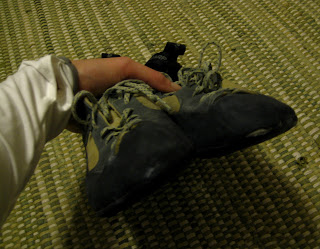 |
| My Scarpa Technos in need of a little TLC! |
Why Not Just Buy New Shoes?
This is the obvious question. If your shoes are worn out, there's always an option to go buy new ones. But most of us take a while to break our shoes in. We love them. I have sentimental attachments to a number of intimate objects. Plus, good climbing shoes are expensive unless you're lucky enough to have a pro deal. I'd much prefer to resole my Scarpa Technos for $42.50 than pay upwards of $100 for a new pair.
DIY or Go With The Pros?
It is possible to resole climbing shoes yourself, though I don't know anyone who has. (If you have, tell me in the comments!) I read this article and decided that wasn't an option for me. After polling the twitter climbing community for the best place to send rock shoes for resoling, the obvious choice was Rock and Resole in Boulder. Aside from doing a bang up job on my shoes, they were incredibly helpful in explaining the parts of a climbing shoe, the different kinds of rubber, and what kind of resole I'd need.
Parts of a Climbing Shoe
The sole is the bottom part of the climbing shoe, and the rand is the rubber layer above the sole that wraps around the shoe, including over the toe. Most rock shoes have a tongue, heel and lacing or velcro, just like normal shoes. This page has a great illustration of the various parts.
Types of Resoling
Rock and Resole and equivalent shops will offer different types of resoles depending on the damage. Options usually include half and full resoles along with rand repair. A half resole involves just replacing the rubber at the ball of the foot while a full resole involves replacing, as you might guess, the entire sole. Shops will usually charge separately for rand repair, which you'll need if you've really blown through the toes. The folks at the shop will either grind off or release the rubber from the shoe and glue on new rubber while doing their best to maintain the shoe's original shape.
 |
| Bouldering at Earth Treks. (P. Esteso) |
This is an exhausting concept to learn about. Most long time climbers have a wealth of knowledge about how each brand of rubber wears and a subsequent brand preference. What I know is only a minuscule drop in the ocean that is information about rock shoe rubber. Rick Radliff wrote a thorough post about it and I'd highly recommend it. Rock and Resole carries what they consider the best on the market, and they believe the differences between rubber are minimal. They carry La Sportiva XS Edge 4 and 5mm, Five Ten C4, Onyx and can create a mix. I opted for the XS Edge 4mm because that's what my favorite bouldering shoes, the Miuras, come with.
Regarding thickness, the guys at Rock and Resole explained that thicker rubber will give you less sensitivity, but more durability. The majority of shoes come with 4mm rubber, but depending on the type of climbing you're doing, thicker might be better. Though thinner rubber wears out faster, it's often preferred because of the increased sensitivity.
The Verdict After My First Resole
The folks at Rock and Resole did a fantastic job. I ended up getting half soles on both shoes and one toe cap for $42.50 including shipping. I sent the shoes out from Philadelphia on January 21st and they made it back to me in less than two weeks. I'd consider that a pretty quick turnaround with shipping time included. The shoes look and feel like they've got a better edge than they did when I bought them. They're still soft, flexible, a lot stickier and a lot less stinky!
Have you ever resoled your own shoes, or had them resoled? Do you think it was worth it? Tell me in the comments!
